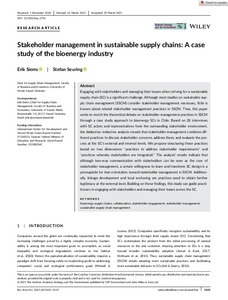| dc.date.accessioned | 2022-01-05T17:16:35Z | |
| dc.date.available | 2022-01-05T17:16:35Z | |
| dc.date.issued | 2021-05-01 | |
| dc.identifier | doi:10.17170/kobra-202112095214 | |
| dc.identifier.uri | http://hdl.handle.net/123456789/13495 | |
| dc.description.sponsorship | Gefördert im Rahmen des Projekts DEAL | ger |
| dc.language.iso | eng | eng |
| dc.rights | Namensnennung-Nicht-kommerziell 4.0 International | * |
| dc.rights.uri | http://creativecommons.org/licenses/by-nc/4.0/ | * |
| dc.subject | bioenergy supply chains | eng |
| dc.subject | collaboration | eng |
| dc.subject | stakeholder engagement | eng |
| dc.subject | stakeholder management | eng |
| dc.subject | sustainable supply chain management | eng |
| dc.subject.ddc | 330 | |
| dc.title | Stakeholder management in sustainable supply chains: A case study of the bioenergy industry | eng |
| dc.type | Aufsatz | |
| dcterms.abstract | Engaging with stakeholders and managing their issues when striving for a sustainable supply chain (SC) is a significant challenge. Although most studies on sustainable supply chain management (SSCM) consider stakeholder management necessary, little is known about related stakeholder management practices in SSCM. Thus, this paper seeks to enrich the theoretical debate on stakeholder management practices in SSCM through a case study approach to bioenergy SCs in Chile. Based on 28 interviews with SC actors and representatives from the surrounding stakeholder environment, the deductive–inductive analysis reveals that stakeholder management combines different practices to discuss stakeholder concerns, address them, and evaluate the process at the SC's external and internal levels. We propose structuring these practices based on two dimensions: “practices to address stakeholder requirements” and “practices whereby stakeholders are integrated.” The analysis' results indicate that although two-way communication with stakeholders can be seen as the core of stakeholder management, a certain willingness to learn and transform SC design is a prerequisite for true orientation toward stakeholder management in SSCM. Additionally, linkage development and local anchoring are practices used to obtain further legitimacy at the external level. Building on these findings, this study can guide practitioners in engaging with stakeholders and managing their issues across the SC. | eng |
| dcterms.accessRights | open access | |
| dcterms.creator | Siems, Erik | |
| dcterms.creator | Seuring, Stefan | |
| dc.relation.doi | doi:10.1002/bse.2792 | |
| dc.relation.projectid | Grand Nummer: 57160015 | |
| dc.relation.projectid | Grand Nummer:031B0056C | |
| dc.subject.swd | Bioenergie | ger |
| dc.subject.swd | Nachhaltigkeit | ger |
| dc.subject.swd | Supply Chain Management | ger |
| dc.subject.swd | Kollaboration | ger |
| dc.subject.swd | Stakeholder | ger |
| dc.subject.swd | Management | ger |
| dc.type.version | publishedVersion | |
| dcterms.source.identifier | eissn:1099-0836 | |
| dcterms.source.issue | Issue 7 | |
| dcterms.source.journal | Business Strategy and the Environment (BSE) | eng |
| dcterms.source.pageinfo | 3105-3119 | |
| dcterms.source.volume | Volume 30 | |
| kup.iskup | false | |


